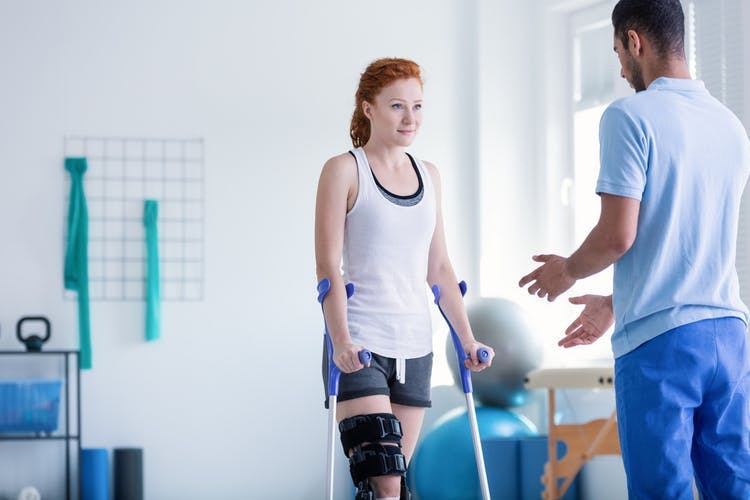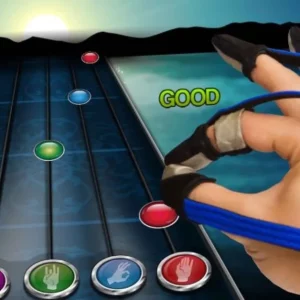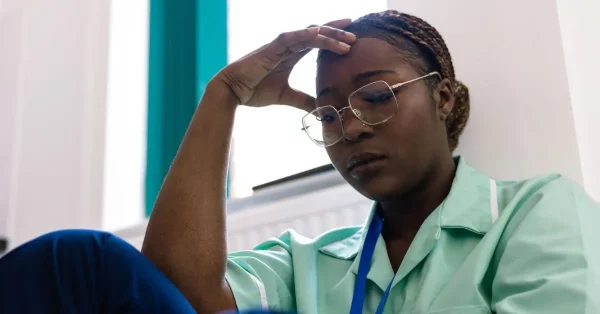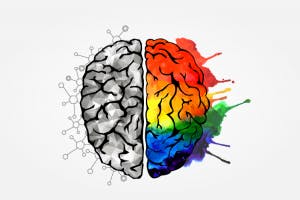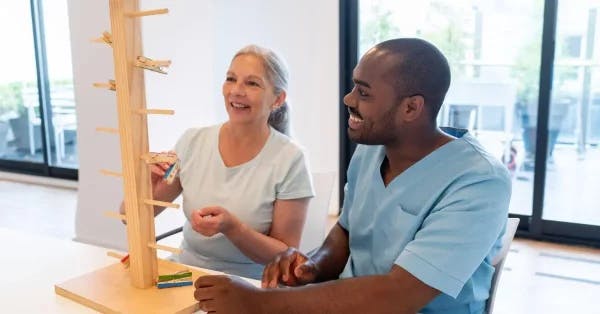Nearly two thirds of all stroke survivors experience difficulty walking after stroke. A survivor’s manner of walking, also known as their gait, can often be improved or even fully recovered through rehabilitation. Consistent participation in a personalized therapy program designed to meet the survivor’s unique needs and abilities can boost recovery outcomes.
This article has been updated to be detailed and comprehensive. There’s a lot of information here, so bookmark this extensive article and use the links below to jump straight to any section:
- Why does walking become difficult after stroke?
- How gait rehabilitation works
- Relearning to walk after stroke
- Mobility aids
- Exercise devices
- Other considerations
- Overcoming the Fear of Walking After Stroke
- How long does it take to walk after stroke?
- What are the chances of walking after stroke?
Why Does Walking Become Difficult After Stroke?
A stroke occurs when the blood supply to the brain is compromised. This deprives brain cells of oxygen and other nutrients, resulting in brain tissue damage. Secondary effects of stroke vary greatly based on which areas of the brain sustained damage. These effects can include changes in cognitive skills, motor abilities, sensation, vision, communication, and personality.
More than half of all stroke survivors age 65 and older experience reduced mobility due to stroke. While some individuals are unable to walk at all after stroke, others experience only minimal changes to their gait pattern (manner of walking).
Major secondary effects of stroke that may affect walking include:
- Hemiparesis or hemiplegia: weakness or paralysis on one side of the body
- Spasticity: involuntary muscle tightness
- Foot drop: inability to lift the front portion of the foot
- Balance issues: can arise due to motor changes, incoordination, numbness/tingling, vision problems, or vertigo
- Pain: may be related to neuropathy, changes in muscle tone, or other factors
Motor impairments after a stroke often impact only one side of the body, opposite from where the damage to the brain occurred. Therefore a right hemisphere stroke may cause difficulty with movement on the left side of the body, while a left hemisphere stroke may affect the right side of the body. One-sided motor deficits and can greatly impact balance and impede walking after stroke.
How Gait Rehabilitation Works
Rehabilitation is key to regaining the ability to walk after stroke. Physical therapists are excellent resources for gait recovery, as they are specially trained in movement restoration. Working with an occupational therapist may also be recommended if difficulty walking affects the ability to participate in the activities of daily living.
Participating in physical and/or occupational therapy can boost recovery by stimulating adaptive changes in the brain. This is because consistently and repetitively practicing targeted tasks activates neuroplasticity, the mechanism by which the brain repairs and rewires itself.
Neuroplasticity helps the brain become more efficient with tasks that are performed regularly by creating and strengthening neural pathways. When specific exercises and activities are repetitively practiced, the brain perceives a need for the associated functions and makes the related neural pathways stronger.
Stroke survivors often begin their rehabilitation process in the hospital. Upon discharge, they may be recommended to pursue home health or outpatient rehabilitation. Alternatively, individuals may move to an inpatient rehabilitation center, where they participate in multiple hours of therapy per day.
In each of these settings, physical therapists can use personalized exercises and activities to help restore movement and coordination, strengthen the muscles, and retrain the brain. Continuing to practice therapy tasks related to walking even outside of therapy sessions can promote optimal improvements.
Relearning to Walk After Stroke
Physical therapy often involves a combination of passive stretches, active exercises, and therapeutic modalities. The best exercises are those that are challenging, yet not overly difficult to perform. With consistent practice, it is even possible for some individuals with post-stroke paralysis to recover the ability to walk independently.
Here are a few exercises and techniques that physical therapists may use to improve walking skills after stroke:
Passive Exercises
Especially helpful for individuals with little to no active movement in their legs, passive exercises involve gentle stretches, often performed by a therapist or trained caregiver. Passive exercises may be used for a number of reasons, including to improve flexibility, prevent contractures, increase blood flow, and stimulate the brain.
To improve walking abilities, passive exercises often focus on ankle, knee, and hip movement. Combining passive exercise with mental practice by visualizing oneself performing targeted movements can enhance results. As movement improves, individuals may be able to move onto active exercises.
Explore passive exercises for stroke survivors »
Active Exercises
Different than passive exercises, active exercises involve using one’s own strength to perform a specific movement. Both leg and core exercises are essential for regaining the ability to walk. Weights and resistance bands may also be added as needed. Active exercises that physical therapists may recommend include:
- Seated marches: while sitting, raise one leg at a time toward the chest as if marching, then relax the leg back down
- Toe taps: starting with the feet flat on the floor, raise the toes up, then lower them back down
- Sit-to-stands: beginning in a seated position, push up to standing, using a table or countertop for support if needed, before returning to sitting
Physical therapists may recommend different exercises based on the individual’s skill level and which factors are impeding their ability to walk. For example, an individual who is struggling to walk due to foot drop will likely focus on different exercises than someone whose walking skills are impaired due to poor balance.
Feel free to use the links below to explore other exercises that may help improve walking after stroke:
Leg Exercises for Stroke Recovery
Core Exercises for Stroke Patients
Balance Exercises for Stroke Patients
Exercises to Improve Foot Drop
Gait Training
Perhaps the most specialized method for relearning to walk after stroke, gait training focuses on improving walking patterns. This is especially beneficial for individuals who have sufficient movement and strength to walk, but have yet to achieve their normal gait pattern.
While gait training can include leg, core, and even arm exercises, it may also involve walking practice with real-time feedback from a physical therapist. Gait training may also involve walking on different surfaces or navigating sidewalks and curbs to improve safety and independence.
Explore gait training exercises »
Aquatic Therapy
Participating in aquatic therapy can be extremely beneficial when relearning to walk. Warm pool water can relax muscles and aid in pain relief. Furthermore, while moving against water resistance can help improve muscle strength, the buoyancy of water allows individuals to practice moving with less weight on their joints and can reduce the fear of falling.
Modalities
Physical therapists may also utilize treatment modalities like massage or electrical stimulation (e-stim) to improve walking after stroke. These treatments are most effective when used in conjunction with therapeutic exercises.
E-stim involves placing electrodes on the skin and using an electrical current to stimulate affected muscles. This can retrain the brain to activate the muscles needed for walking. Again, e-stim tends to be most effective when visualizing targeted movements.
Massage can help relieve pain, reduce muscle tightness and spasticity, and improve circulation. Therefore, manual techniques like massage can help prepare the body for optimal movement.
Mobility Aids to Help Stroke Survivors Walk
Walking devices that are used following a stroke can vary greatly depending on the survivor’s needs and skill level. Mobility aids that may be used include:
- Front-wheeled walkers
- Platform walker
- Hemi walkers
- Four-wheeled walkers
- Quad canes
- Single point canes
As individuals improve their strength, balance, and coordination, they may be able to transition to less stable walking devices, or be able to walk safely without using a mobility aid at all. However, for optimal outcomes, it is important for survivors to use any walking device recommended by their therapist and to practice rehabilitation exercises consistently.
Explore mobility aids on Amazon »
Exercise Devices to Improve Walking After Stroke
Following along with written sheets of exercises can be tough due to low accountability and potential boredom. Those who struggle with motivation to exercise may benefit from exploring exercise devices that may be more engaging, such as:
Anti-gravity treadmills
Unlike most treadmills, anti-gravity treadmills are able to help support some of the user’s body weight. This can allow individuals to practice the movements involved in walking, even if they do not yet have sufficient strength or endurance to walk independently. These are very expensive and usually offered at rehabilitation facilities. Some clinics may also have bodyweight support systems that can be used in a similar fashion.
NuStep
The NuStep is a type of recumbent cross-trainer frequently used in rehabilitation clinics. It allows individuals to sit while moving the arms and legs forward and back, alternating sides in a gentle gliding motion to activate muscles commonly used during walking. Again, these are rather expensive and therefore often best to use during physical therapy sessions.
Stationary Bikes
Stationary bikes may be used at home or in a clinic to help with gait recovery. These are particularly appealing for individuals with hemiplegia or severe hemiparesis, because the non-affected leg can help assist movement in the affected leg, encouraging neuroplasticity. As stationary bikes primarily target the legs and core, it’s important to use other rehabilitation methods as well to target the full body.
FitMi Home Therapy
Home rehabilitation devices, such as FitMi Home Therapy, can target the whole body and turn physical therapy exercises into an interactive experience. FitMi can provide personalized exercises and encourage survivors to accomplish high repetition of therapeutic exercises, which helps spark neuroplasticity and rewire the brain.
Other Considerations for Gait Rehabilitation After Stroke
As individuals begin to pursue gait rehabilitation, there are a few other points to consider:
- Individuals who have difficulty walking are at a heightened risk of falls. Consider practicing exercises with a caregiver nearby or close to a stable surface, such as a countertop, if balance is a concern. Using recommended mobility aids can also reduce the risk of falling.
- Survivors who experience vision problems after stroke often have difficulty walking. Optometrists, neurologists, and occupational therapists are all great resources for improving vision after stroke.
- Hemineglect is a common post-stroke condition that causes stroke survivors to be completely unaware of their affected side. This condition may cause individuals to run into walls, chairs, or other objects on their affected side. A speech or occupational therapist should address it before individuals can safely walk after a stroke.
Addressing any other underlying issues that may affect walking, such as vertigo or numbness, is essential in order to regain the ability to walk safely and effectively. Survivors can talk with their doctor or therapist to learn more about underlying conditions that may affect the ability to walk after stroke.
Overcoming the Fear of Walking After Stroke
It’s common for stroke survivors to feel afraid of walking again—especially if they’ve experienced a fall or struggle with balance. Even when the body starts to recover, the fear of falling or losing control can hold someone back from making progress. Left unaddressed, this fear can slow recovery and lead to decreased strength, mobility, and confidence.
Fortunately, there are several effective ways to overcome this fear and rebuild trust in your body:
- Start with supported walking. Use parallel bars, a walker, or walk with a therapist to practice safely.
- Set small, achievable goals. Begin with short distances—such as walking across a room—and gradually increase over time.
- Practice in safe environments. Choose clear, clutter-free spaces with level surfaces to reduce the chance of tripping.
- Use recommended mobility aids. Canes, walkers, or orthotics can boost both stability and confidence.
- Visualize success. Mental practice—picturing yourself walking safely—can ease anxiety and improve outcomes.
- Track your progress. Keeping a simple log of your walking distance or time can help you stay motivated and recognize improvement.
- Ask for support. Practicing with a therapist or caregiver nearby can offer reassurance and a safety net.
- Talk about your fears. Sharing your concerns with your rehab team allows them to tailor therapy to build confidence gradually.
With the right strategies and support, fear doesn’t have to stand in the way of walking again. Progress often starts with one small, supported step—and builds from there.
How Long Does It Take to Walk After Stroke?
The timeline for regaining the ability to walk after a stroke varies greatly from person to person. Factors such as stroke severity, location of brain damage, age, overall health, and the intensity of rehabilitation all play a role in recovery.
However, while stroke recovery timelines can vary greatly, studies have found some common predictors of regaining the ability to walk after stroke. According to the Time to Walking Independently after STroke (TWIST) prediction tool, individuals who are younger, have greater knee extension strength, and have better sitting and standing balance are more likely to regain the ability to walk after stroke.
This does not mean that those who are older, have poor knee extension strength, or lack sitting and standing balance will never recover the ability to walk. It simply means that rehabilitation may require more effort and hard work.
Participating in rehabilitation early on in the stroke rehabilitation process can boost outcomes. Neuroplasticity is enhanced during the first 3-6 months after stroke, thus the greatest improvements tend to occur in this timeframe. However, even if independent walking is not achieved during this time, it is still possible to make improvements years after stroke.
What Are the Chances of Walking After a Stroke?
The majority (up to 85%) of all stroke survivors are able to walk independently by 6 months after their stroke. This is an encouraging statistic that highlights the potential for recovery, especially with timely and consistent rehabilitation.
However, recovery outcomes can vary. For stroke survivors who initially require assistance to walk, only 60% of survivors who initially required assistance with walking after stroke regain the ability to walk independently. This often is a result of the severity of the stroke, the presence of other medical conditions, and how soon and intensively rehabilitation begins.
Even if walking does not return quickly, it’s important to remember that recovery is still possible. With the help of physical therapy, neuroplasticity, and ongoing practice, many survivors continue to make meaningful improvements in their walking ability over time—even beyond the six-month mark.
Hope for Walking After Stroke
The ability to walk independently is a major goal of many stroke survivors. Participating in physical therapy and consistently practicing targeted exercises and activities can help individuals achieve this goal.
Repetitively practicing exercises both during therapy and at home can promote optimal results. Therefore, using regularly home exercise programs and/or home therapy devices like FitMi can encourage adaptive brain rewiring and help survivors regain the ability to walk after stroke.

